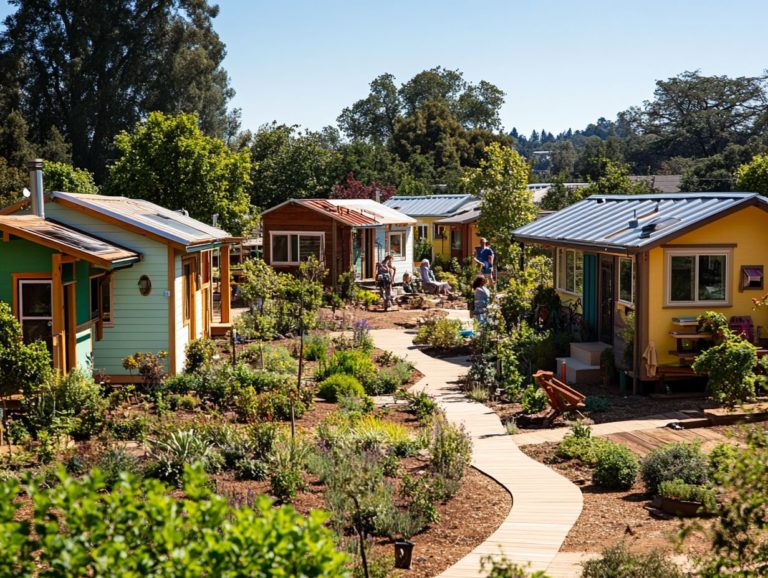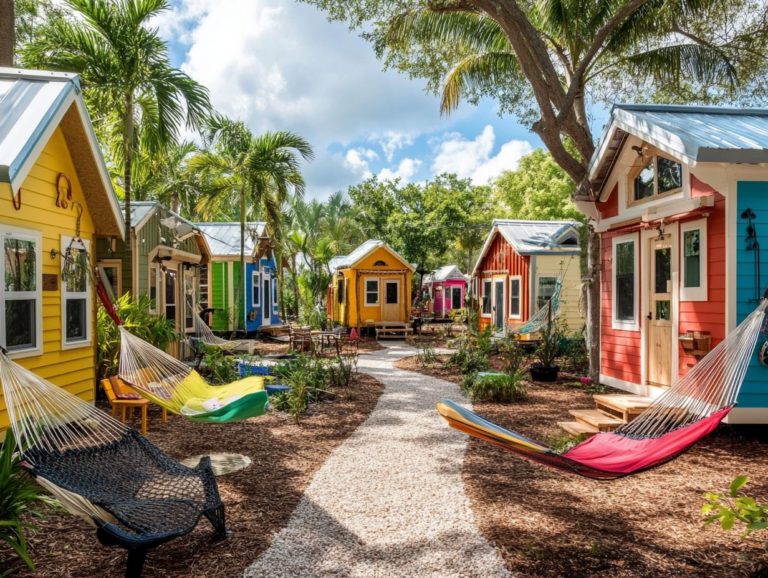Tiny House Communities: A Guide to Social Interaction
Tiny house communities transcend mere trendiness; they embody a profound shift toward sustainable living and intentional community-building.
This exploration delves into what precisely defines these distinctive living arrangements, highlighting the myriad benefits they offer and the essential factors to consider when establishing one.
From fostering social interactions to setting community guidelines, we will address the joys and challenges that accompany tiny house living.
Uncover how these close-knit communities have the potential to enrich your lifestyle while championing environmental responsibility.
Contents
- Visual Guide to Key Insights!
- Discover the Magic of Tiny House Communities!
- Building and Designing a Tiny House Community
- Creating Community Rules and Guidelines
- Social Interaction in Tiny House Communities
- Common Challenges and Solutions
- Benefits of Living in a Tiny House Community
- Frequently Asked Questions
Visual Guide to Key Insights!

- Experience a true sense of belonging in a supportive tiny house community.
- Design spaces that encourage friendly interactions and memorable moments.
- Establish clear rules and guidelines to promote inclusivity and communication.
Discover the Magic of Tiny House Communities!
Understanding Tiny House Communities means diving into a contemporary lifestyle that champions living simply and with less stuff and financial independence through shared resources and cooperative living.
These communities, typically featuring eco-friendly tiny homes, embody the burgeoning tiny house movement, which prioritizes sustainability and affordable housing solutions.
As a resident, you ll enjoy the advantages of strong community connections and shared amenities, cultivating a culture of collaboration and mindfulness while effectively minimizing your environmental footprint.
What are Tiny House Communities?
Tiny house communities are intentional living spaces designed for individuals and families who choose to reside in compact, eco-friendly homes. Here, the focus is on community, shared resources, and a commitment to environmental responsibility.
In these unique arrangements, you’ll find thoughtfully designed layouts that encourage interaction among residents, cultivating a true sense of belonging. Central features often include inviting common areas think cozy gathering spots and adaptable meeting spaces that promote social connections and collaborative endeavors.
Many of these communities also feature abundant gardens where you can join your neighbors in cultivating fruits and vegetables, fostering sustainable practices and healthy living. Recreational spaces are tailored for both relaxation and activities, allowing you to engage in various outdoor pursuits.
Ultimately, this lifestyle creates a supportive environment that prioritizes shared sustainability while enriching the lives of everyone involved.
Benefits of Living in a Tiny House Community
Living in a tiny house community brings a host of advantages, from enjoying financial freedom with lower living costs to making a positive environmental impact through sustainable practices. Plus, you ll find that these communities foster a spirit of collaboration and resource sharing.
For many, transitioning to a smaller living space translates to significantly reduced utility bills and minimal mortgage payments. This newfound financial flexibility allows you to direct funds toward experiences that enrich your life, rather than getting lost in a sea of possessions.
This shift promotes personal savings and a commitment to sustainability, as many community members embrace eco-friendly practices like gardening and composting. The close-knit nature of these communities nurtures genuine friendships, enabling neighbors to engage in communal events and lend support during challenging times.
You ll notice that these communities often develop systems of mutual aid, enhancing collective well-being by sharing resources, skills, and emotional support. This transformation redefines the concept of home into a vibrant, interconnected lifestyle.
Building and Designing a Tiny House Community
Building and designing a tiny house community requires meticulous planning and thoughtful consideration of several key factors. You’ll need to envision the layout of tiny house villages, foster robust community support systems, and thoughtfully integrate shared amenities that elevate the communal living experience.
Factors to Consider
When building a tiny house community, several critical factors must be considered, such as tiny house laws, environmental impact, and a commitment to sustainable living.
Navigating the regulatory landscape of tiny house laws is vital for compliance and sustainability. These regulations determine lot sizes, zoning classifications, and utility connections, which are essential for your project’s success.
The environmental implications of establishing such communities extend beyond the construction phase. You ll need to think about resource consumption, waste management, and the preservation of local ecosystems.
By prioritizing sustainable building materials and efficient energy solutions, you can significantly improve the environmental impact of your project. These laws and considerations will shape your plans, influencing the physical layout of your community and fostering a culture of collaborative living that values eco-consciousness and shared resources.
Designing for Community Interaction
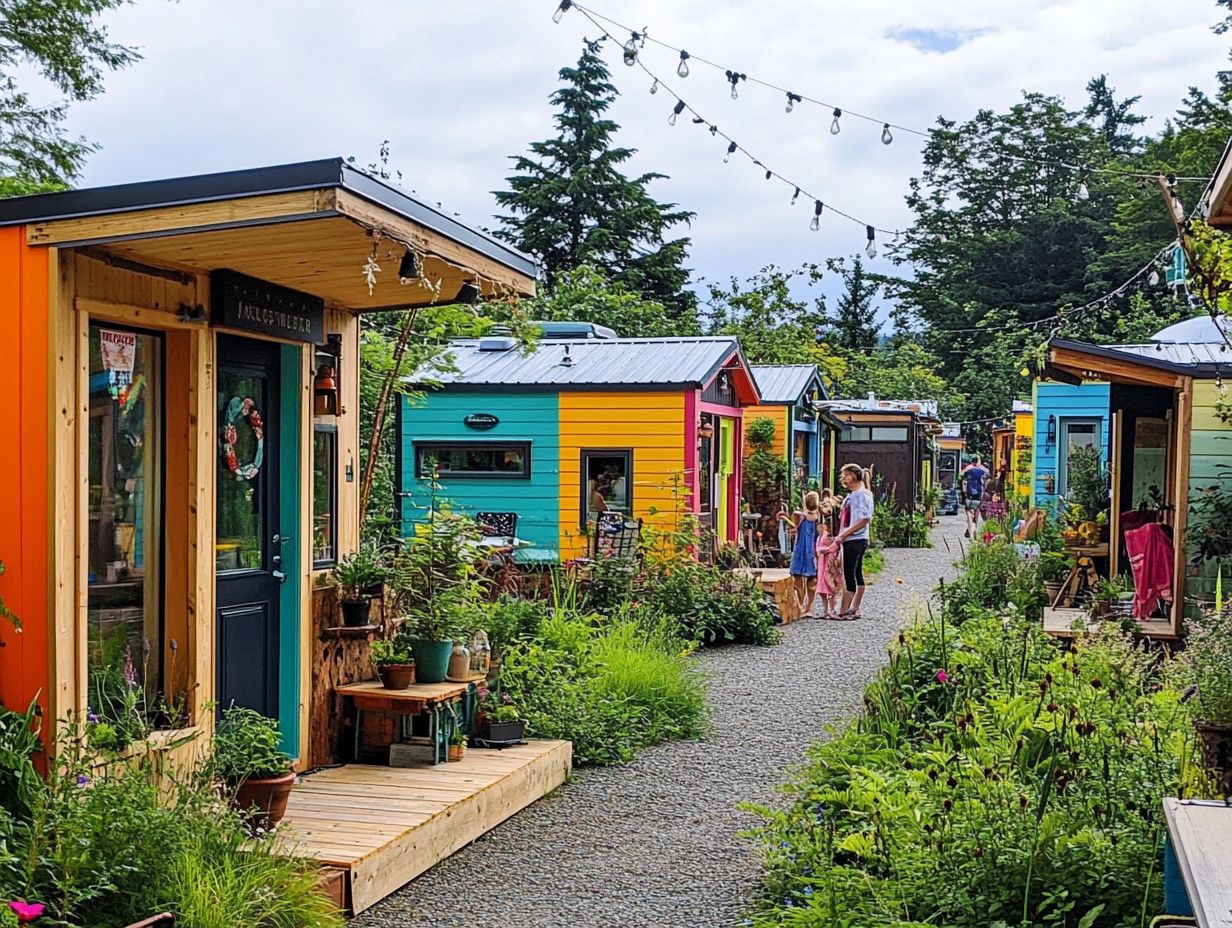
Designing for community interaction is crucial in tiny house communities. Thoughtfully crafted common areas and shared resources inspire connections among neighbors.
Key design features that enhance engagement include communal gardens, fitness centers, and recreational spaces. These elements bring people together and encourage shared experiences.
Communal gardens provide more than fresh produce; they create hubs for exchanging gardening tips and recipes, fostering friendships and a sense of belonging.
Fitness centers promote an active lifestyle, offering group class opportunities that allow neighbors to bond over shared fitness goals.
Well-designed recreational areas, complete with picnic spots and playgrounds, serve as venues for community events. They invite everyone to come together, share stories, and celebrate life. This vibrant interaction brings life to communal living and makes every moment special!
Creating Community Rules and Guidelines
Establishing community rules and guidelines is essential for cultivating a thriving tiny house community. This framework fosters cooperative living and encourages community support and a shared commitment to sustainability.
Importance of Establishing Rules
Establishing rules within tiny house communities is vital for maintaining harmony and ensuring that all residents align around a shared vision of environmental responsibility.
These regulations create a framework that nurtures mutual respect among neighbors and stimulates collaboration in tackling communal challenges. Clear guidelines on noise, shared spaces, and maintenance can greatly improve everyone’s quality of life.
These rules help cultivate an environment where individuals feel safe to voice their needs and concerns, paving the way for constructive dialogue and effective conflict resolution.
This foundation of trust is crucial for developing a vibrant community where everyone contributes to a sustainable lifestyle. It enables strong connections and shared goals that go beyond mere coexistence.
Examples of Community Guidelines
In tiny house communities, you ll often encounter community guidelines designed to foster sharing resources and community duties. These rules ensure that every member actively contributes to a positive living environment.
You might see these guidelines take shape through various initiatives, like scheduled communal meals that build connections, shared tool libraries that lighten individual loads while promoting sustainability, or designated quiet hours that help maintain a serene atmosphere. Additionally, exploring tiny house communities can foster new friendships and enhance the sense of community.
For example, a cooperative composting initiative allows neighbors to manage waste together, educating residents on eco-friendly practices and strengthening the community s bonds.
By embracing such thoughtful rules, you can look forward to improved interactions, a deeper sense of belonging, and enhanced cooperation all elements that enrich your communal living experience and cultivate a vibrant, supportive atmosphere.
Social Interaction in Tiny House Communities
Social interaction within tiny house communities is vital for cultivating a robust sense of belonging and support. This is enhanced by shared amenities and a culture of mindfulness that emphasizes community engagement.
Types of Social Activities
In tiny house communities, you’ll find a delightful array of social activities, from cozy potlucks and invigorating yoga classes to collaborative gardening and skill-sharing workshops all designed to cultivate a vibrant culture of sharing.
These gatherings give you the chance to bond over shared meals and holistic practices while encouraging the exchange of skills and resources. Participating in a community gardening day allows you to come together with others to cultivate plants, fostering teamwork and a genuine sense of ownership in the communal space.
Joining workshops on carpentry or sewing empowers you, boosting your self-sufficiency while nurturing meaningful friendships. Organizing movie nights or book clubs creates a relaxed atmosphere for engaging conversations, further solidifying connections in this close-knit environment.
Such activities are vital for building trust and enhancing social cohesion, ultimately enriching the community experience for everyone involved.
Promoting Inclusivity and Communication
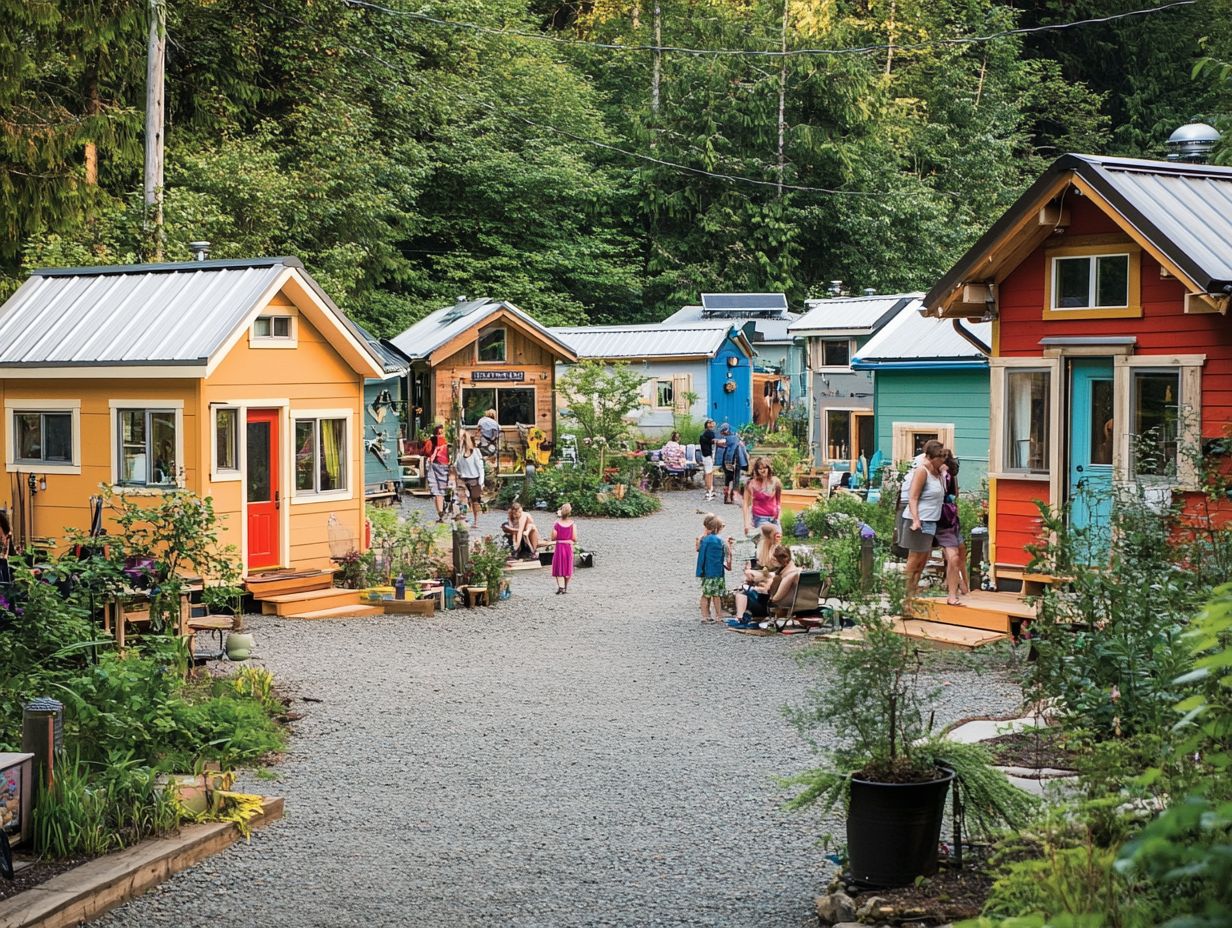
Creating a warm and welcoming atmosphere in tiny house communities is key! Fostering an environment where every resident feels valued and heard is critical in these close-knit living arrangements.
By holding regular community meetings and encouraging open dialogue, you empower members to voice their ideas, concerns, and aspirations. This not only fosters understanding but also strengthens interpersonal connections.
Utilizing community boards or digital forums enhances these interactions, making it easier for everyone to share resources and information. Organizing activities like potluck dinners or group gardening projects offers fantastic opportunities for individuals to connect on a personal level, reinforcing the sense of belonging.
Ultimately, these strategies lay the groundwork for cultivating a supportive and vibrant community spirit.
Common Challenges and Solutions
In tiny house communities, you ll often encounter common challenges such as navigating the complexities of tiny house laws, managing the constraints of limited space, and upholding the principles of cooperative living among residents.
These factors require careful consideration and collaboration to create a harmonious and thriving environment.
Addressing Conflicts
Addressing conflicts in tiny house communities requires a thoughtful approach that prioritizes support and cooperation. It’s crucial to implement conflict resolution strategies. These foster open communication and create an environment where residents feel safe to share their concerns.
Regular community meetings encourage dialogue. This builds trust among residents and paves the way for harmonious living.
By embracing these strategies, you can help resolve issues. This also strengthens the bonds within tiny house communities.
Dealing with Limited Space
Navigating limited space in tiny house communities can be challenging. However, it inspires innovative solutions like shared amenities.
Creative strategies maximize every square foot. Shared gardens and communal kitchens can transform interactions among neighbors.
Using multifunctional furniture enhances comfort. Embrace a lifestyle that emphasizes collaboration for a better quality of life.
Benefits of Living in a Tiny House Community
Living in a tiny house community offers many advantages. You’ll enjoy financial freedom with lower living costs.
The sense of community support fosters connections. Sustainable living practices reduce your environmental impact.
Sense of Belonging and Support
In tiny house communities, you ll find a strong sense of belonging. Residents rely on one another and share resources effectively.
This supportive environment enhances well-being. It also strengthens interpersonal relationships, creating deeper bonds than traditional neighborhoods.
Gathering for communal meals and gardening fosters unity. Frequent interactions allow you to form meaningful connections effortlessly.
Close-knit settings encourage collective problem-solving. This significantly alleviates stress and promotes happiness in daily life.
Reduced Environmental Impact
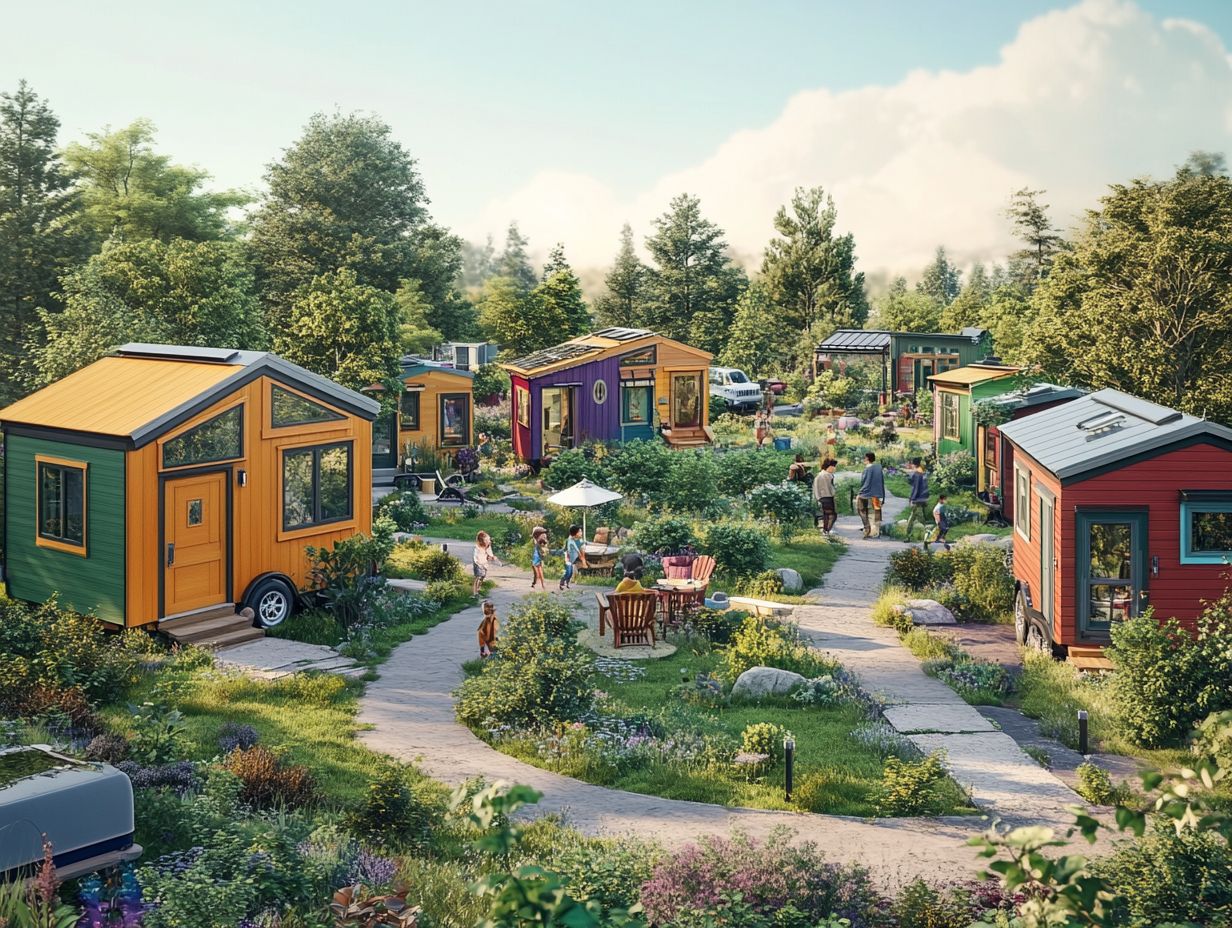
Living in tiny house communities significantly reduces environmental impact. This aligns with the tiny house movement’s focus on sustainability.
Embracing minimalism leads to reduced energy consumption and waste generation. Resource-sharing practices enhance community and sustainability.
Collaborative ventures minimize resource excess. This promotes a greener lifestyle in line with sustainable principles.
As more individuals adopt eco-friendly habits, tiny house communities exemplify mindful living. They effectively lower ecological footprints and inspire others.
Frequently Asked Questions
What is a tiny house community?
A tiny house community is a small group of individuals living in tiny homes, typically with shared amenities. These communities focus on sustainable and minimalist living.
How do people interact in a tiny house community?
People in tiny house communities often interact through shared spaces and activities such as community gardens and workshops.
Many members also participate in decision-making processes and community initiatives together.
Why are tiny house communities gaining popularity?
Tiny house communities are booming! The rising cost of housing, a push for sustainable living, and a craving for community connection are driving this trend.
What are some challenges of living in a tiny house community?
Living in a tiny house community can be thrilling, but it also comes with challenges. Limited space and shared arrangements can lead to conflicts, so open communication is key!
Can anyone join a tiny house community?
Most tiny house communities have specific membership criteria, such as age restrictions and a commitment to sustainable living. Research the community’s guidelines and values before applying to join.
Are there different types of tiny house communities?
Yes, there are different types of tiny house communities, such as intentional communities and co-housing communities. Each type focuses on unique values, so find one that aligns with your lifestyle.


